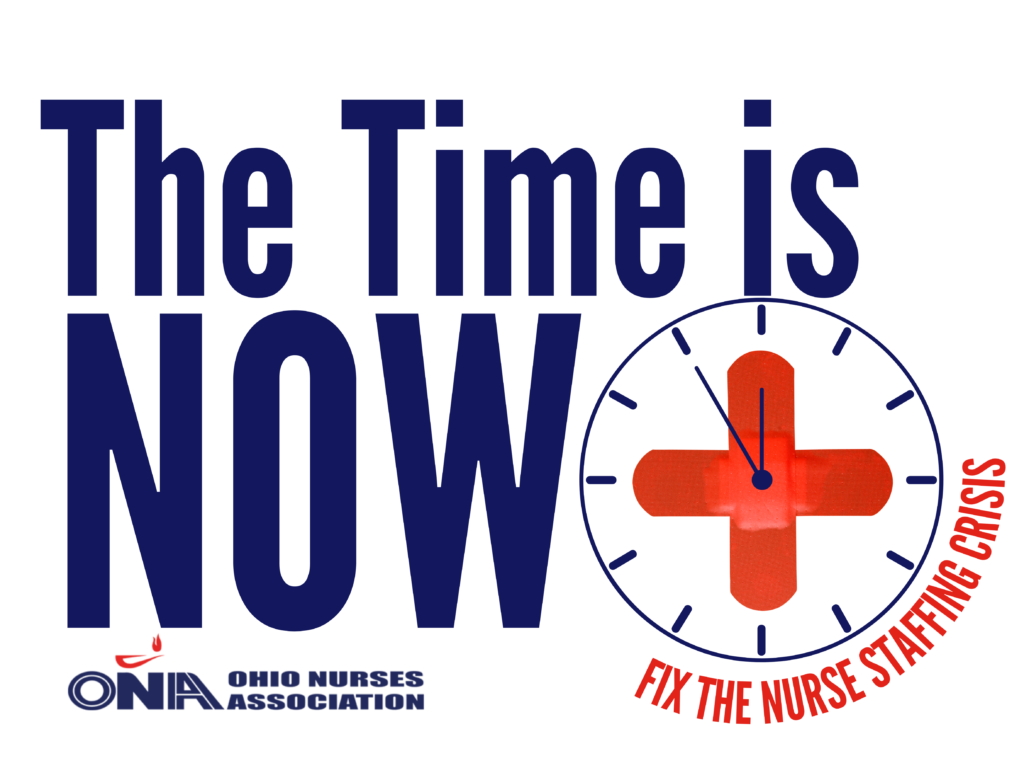Ohio Nurses,
For the first time ever, we have the nation’s attention. The media, the public, and even hospital CEOs are (finally) worried about nurse staffing. We are in a time when everyone’s ear is ready to listen. We must make sure it’s our voice they’re hearing.
A New York Times opinion piece, by way of video, got it right: greedy hospitals have intentionally understaffed nurses for decades. And this isn’t a Covid problem. This is a culmination of nurses being ignored for years, and now we’re a facing a crisis. That crisis isn’t a nursing shortage, but rather a shortage of nurses willing to work at the bedside.
Why are nurses continually ignored, though year after year we shout for help? Hospital lobbyists are powerful and have consistently blocked common sense legislation at both the federal and state level, Ohio included. One could also blame staffing as hospitals’ biggest budget item, and therefore easiest to cut. And I heard a female colleague once remark about a correlation between this female-dominated profession and the historical undervaluing of women in the workplace as evidenced by lower pay and less women in executive roles (even within our own profession). She wondered, does the proverbial glass ceiling exist for nurses? Is there glass to smash?
I infer our situation is a product of all three scenarios. And our make-it-work attitude (because what choice have we had) left decision-makers believing their own justifications that ignored our cries and the science that backs them. It has been their ‘whatever’ in the ‘whatever helps them sleep at night.’
So now that we have everyone’s ear, let’s shout like we’ve never shouted before. Let’s unify and speak our truths. The Time is Now to created meaningful and systemic changes to fix the nurse staffing crisis. We have to make sure that we’re heard, and that means talking over those who have historically put their own agenda before the needs of nurses and patients. We have to make sure their ‘whatever’ now keeps them up at night.
We need common sense staffing legislation that includes nurse-to-patient ratios. We need to address workplace violence and create an environment where nurses-turned-victims feel supported. We need more nurse educators to prepare our future. We need incentives for nurses educated in Ohio to stay and work in Ohio, and real retention efforts to keep nurses at the bedside. And we need health systems to realize that we can’t do this by ourselves. We need the appropriate ancillary staff to help provide the care our patients deserve.
It’s evident the current system isn’t working. Nurses are at their breaking point. Our profession needs us to come together and take the reins of this once in a lifetime opportunity for the powers-at-be to listen.
This is our movement and change is upon us; I can feel it. The time is now.
Your ONA President,
Robert Weitzel, BSN, RN
With over 40% of nurses considering leaving the profession, #TheTimeIsNow for meaningful, systemic change.
Media
Group urges lawmakers to address nurse burnout
‘They just can’t take it anymore’: More nurses finding new work leave profession hurting
Resources
Moral Injury in Nursing Since the COVID-19 Pandemic
ONA is working with Representative Casey Weinstein to introduce important legislation to curb workplace violence against healthcare workers. Tell your representative to support this legislation by co-sponsoring!
#TheTimeIsNow to trust the most trusted profession.
ONA is at the ready to work with Ohio policymakers to bring about meaningful, systemic changes to fix the nurse staffing crisis. We implore state officials to:
- Convene stakeholders to identify short- and long-term solutions to nurse staffing problems. These solutions must address current COVID-19 staffing issues and beyond, and include legislation that guarantees safe staffing standards (nurse-to-patient ratios), while addressing other workplace conditions that contribute to nurses leaving the bedside.
- Prioritize the recruitment of nurse educators and work with the Ohio Department of Higher Education and other stakeholders to evaluate potential barriers in higher education.
- Prioritize new graduate support through grant and residency/fellowship programs, that will increase the nursing workforce pipeline, while also supporting new graduates as they enter the workforce.
- Incentivize nurses, especially those who graduate from Ohio education programs, to remain in Ohio and work at the bedside.
- Develop a hospital regulatory board through the hospital licensure rule-making process, who will develop and enforce hospital standards, while ensuring workforce safety and retention.

